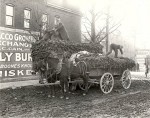“The Indians and early pioneer settlers raised their own tobacco in Marion, Illinois and vicinity in the early 1800’s, but tobacco became the principal money crop shortly after 1840.
In 1840, M.S. Ensminger shipped 1,100 hogsheads of tobacco to the New Orleans market. So general was the industry at that time, and so profitable as well, that Marion was often filled with large farm wagons loaded with hands of tobacco.
As many as fifty tobacco wagons have been counted at one time parked at the public square hitching posts waiting their turns to be received at the tobacco warehouses where the tobacco was graded, weighed and purchased. Fortunes were made and lost in the tobacco business in this county and most of the farms in the county either raised tobacco to sell, or for their own use.
After the close of the Civil War the government surrounded the business with many regulations and restrictions and taxed the finished product so heavily that it discouraged the raising of tobacco, and declining prices reduced the interest. The business was gradually abandoned and now none is raised commercially in Williamson County.
Tobacco barns were operated in Marion, Illinois by the companies of Goodall and Campbell and F.M. Westbrook.
The Goodall and Campbell barn was located west of the Illinois Central railroad depot. The F.M. Westbrook tobacco barn was located on South Liberty Street and employed between 25 and 30 men.
Early Marion residents remember when farm wagons loaded with tobacco have been waiting in lines four blocks long to be unloaded at the warehouses.
When the tobacco was graded, weighed and purchased at the tobacco warehouses men were employed to cut the strings on the hands and remove the stems. Wages ranged from twenty five cents a day to fifty cents for these workers.
After the tobacco stems were stacked in piles of eight or ten feet high and fifty feet long, they were either burned or destroyed. Today, the modern tobacco plant uses the stems for various commercial purposes, including manufacture of fertilizer and insect powders.
The tobacco was packed in hogsheads after it was stemmed and shipped to New Orleans, where it was sold to eastern markets. Tobacco was not packed except on damp days, because if packed on hot and dry days, the leaves would crumble. Men worked at the warehouses from seven in the morning until five P.M.
During 1886, there was over 2.8 million pounds of tobacco shipped from Marion, Illinois, according to an 1887 history on Williamson and surrounding counties.”
Sam’s Notes: It is known from a fire report on December 20, 1877 that Goodall and Campbell also had a barn located on the Northeast corner of N. Van Buren and W. Union Streets that was completely destroyed. This would be the location where the first permanent firehouse would eventually be built.
Additionally, another fire report dated September 22, 1924 indicates that Sullivan’s Poultry Barn near the Illinois Central depot in later years was originally the Goodall and Campbell tobacco barn built 40 years earlier, around 1884.
It is also known from a fire report dated November 19, 1896 that Frank Goodall and David Mohler built a tobacco factory on the northeast corner of the square in June of 1880. The business went under Goodall and Mohler Cigar and Tobacco Co., according to the report.
(Article originally printed in the Marion Daily Republican on 03/24/1955)

